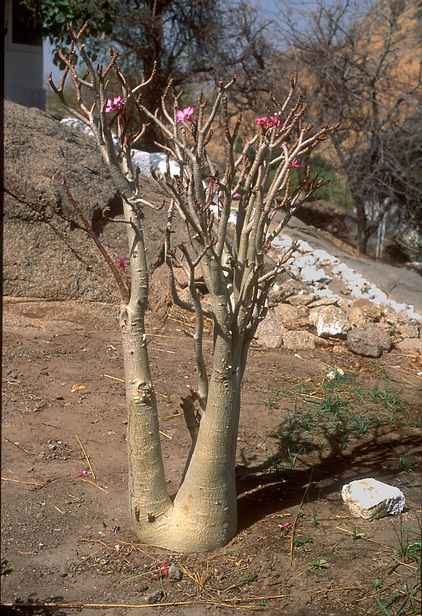An Adenium Website
_edited.png)
_edited_edited.png)
_edited.png)
_edited_edited.png)
The Sahel Group
Adeniums in the Sahel west of Ethiopia are of unknown identity. There are a few herbarium specimens, but no live plants in cultivation that are available for study. In photos the plants look much like A. somalense, but the leaves and flowers look more like those of A. "obesum". If anyone has more photos or live plants from the Sahel (any country east of Ethiopia), please contact me.


Above: Plants of Adenium sp. near Tintane (west of Nema), in southeast Mauritania; bush grassland. Plants from this region have been described as A. honghel; there are no specimens available for study. Photos: Helene Jousse (via Jan Schlogl)
_edited.jpg)

Above: Plants and flowers of Adenium sp. near Tintane (west of Nema), in southeast Mauritania; bush grassland. Plants from this region have been described as A. honghel; there are no specimens available for study. Photos: Helene Jousse (via Jan Schlogl)


Adenium speciosum?
Left two: Plant and flowers of an adenium near Kauda, South Kordofan, Sudan. It looks similar to A. somalense in Ethiopia and Kenya, but plants from this region have been described as Adenium speciosum. Click to enlarge. Photos: submitted by Ricardo Denis.




Adenium honghel?
Left two: Adeniums near Bakel, Senegal. Right two: Adenium near Kedougou, Senegal; this is a mesic habitat for adeniums. Plants from this region have been described as Adenium honghel. The flowers at first appear to have dark throats, but they actually have pink throats overlain with very thick nectar guides. Click to enlarge. Photos: submitted by Ricardo Denis.
Right two: Adenium near Yankari, Alkaleri, NG-BA, Nigeria. Plants from this region have been described as Adenium honghel. This plants's flowers look much like those above from Senegal. Again, the dark-appearing throats are caused by thick nectar guides. Photos submitted by Ricardo Denis.


Adenium "somalense nova"
This taxon was discovered in the mid 1990s in Tanzania, and is in the trade as Adenium "somalense nova". The name is enclosed in double quotation marks to indicate that it is not validly published. In nature the caudex is globular and buried underground, with erect, barely succulent stems to about 4 feet (1.2 m) tall. In cultivation seedlings develop a short-conical caudex that is partially exposed. The plants grow fairly rapidly and make a large caudex compared to the size of the plant in a few years. The small flowers start appearing sparsely at the end of the growing season in fall, followed by a more profuse bloom through the winter while the plants are leafless. They are pink to red at the edges, fading to a white throat with prominent nectar guides. The anther appendages protrude slightly beyond the tube.
Another population that looks very much like this taxon has been found more than 100 km away.

Adenium "somalense nova" collected in Tanzania. The caudexes were underground. Photo: Andre Williams

Six-year-old seedling of Adenium "somalense nova" in a 16-inch pot beginning to flower at the end of the growing season.

Six-year-old seedling of Adenium "somalense nova" in a 16-inch pot flowering during winter dormancy.

Left and Right: Flowers of Adenium "somalense nova".



This group of Adenium "somalense nova" were grown by Hiren Vaghela. This distinct strain has very narrow leaves. Click to enlarge. Photos: Hiren Vaghela.


Adenium "Thai socotranum"
Adenium "Thai socotranum", also called "Thai soco", are not related to A. socotranum. They are in fact dwarf forms of A. "arabicum" bred in Asia. They are extremely popular, and there are many named varieties. See more examples in the Thai socos section in the A. "arabicum" page


"Thai Socotranum" Photo: John Franklin Roosevelt
A. "obesum" near Lake Eyasi, Tanzania
Anomalous adenium plants near Lake Eyasi, Arusha, Tanzania. This is in the geographic range of A. "obesum", but the plants are unusually caudiciform. More important, the flowers are atypical of either species, but closely match those of A. swazicum or boehmianum hundreds of miles to the south. There is a population of these anomalous white-flowered, dark-throated adeniums growing on a rocky granite hill above a hot spring. Photos: David Bygott.
NOTE: There are surely many other anomalous adenium populations in the wild. If you know of any, please contribute photos and other information to further our knowledge of these plants.






Right: ...and a gigantic specimen in the same locality. Click to enlarge. Photo: Chris Schmeling via David Bygott
A. somalense-crispum intergrade?
Adenium near Bulo Burri (Bulobarde), Somalia, between the ranges of somalense and crispum. The leaves appear to be linear and crisped like crispum, but this is a tree like somalense. What is it? These two taxa hybridize readily in cultivation. Photo: John Lavranos.

Adenium coetanum?


An Adenium in the Dirashe District of southwestern Ethiopia, near the borders with South Sudan and Kenya. The plant is the size of A. somalense, and it occurs within the range of that species. But the leaves look like those of "obesum", which begins in southern Kenya. The flowers appear to have dark throats,which, if true, is not characteristic of East African adeniums. This plant is not far from an herbarium specimen labeled A. coetanum. This plant also resembles the old cultivar 'Singapore', which has been sold as A. coetanum. DNA analysis indicates that 'Singapore' is an intergrade between A. "obesum" and A. somalense (Dimmitt and Edwards 2021). Photos: (contributed by Ricardo Denis).

Left: This photo was taken in Ethiopia, where adeniums "should be" A. somalense. But the foliage and flower look like those of A. "obesum". Perhaps this is what has been described as A. coetanum. Photo: Jim & Roxie Esterle






_edited.jpg)


